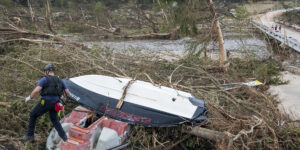Insurance industry scientists put the spotlight on Northern U.S. cities in a new research paper about hurricane potential under a warmer climate scenario, finding that New York’s insured losses could rise by more than 60 percent.
Sam Phibbs and Ed L. Pope, the authors of “Insured U.S. Hurricane Loss Under a 2°C Warmer Climate,” also found that Rhode Island and Massachusetts may see increases of over 70 percent in average annual insurance hurricane loss under a climate scenario that is 2°C warmer than pre-industrial climate compared to a present-day climate (defined as 1.1°C above pre-industrial).
Across the United States, annual average insured losses could rise 39-42 percent and the 1-in-200 aggregate exceedance probability loss could rise by 25-26 percent, the report says.
But “scenario analysis also shows that the impacts are spatially variable, with the greatest relative impacts on the eastern seaboard.”
“These results suggest building codes applied in Gulf Coast states should be applied at higher latitudes to mitigate current and future impacts of climate change,” wrote the authors, who were both members of MS Amlin’s catastrophe research team. (Editor’s Note: Phipps is now Natural Catastrophe Lead for Hiscox, according to his LinkedIn profile.)
To conduct their analysis, the catastrophe research scientists relied on a third-party climate change dataset provided by Reask—specifically, regional rates of change in landfall rate for different intensities of tropical cyclone for a 2°C climate compared to the present-day climate. They then used the data to adjust MS Amlin’s simulated 100,000 year view of landfall rates for the U.S. (which is based on Moody’s medium-term rates, validated to be an appropriate representation of the present-day climate.)
Although Florida is projected to see the largest absolute increase in annual insured losses under the warmer climate scenario, the relative rise in insured losses is just 44 percent above present day.
New York, ranked fourth in terms of absolute insured losses by state under both the present day and warmer climate scenarios, sees a 64 percent jump for a warmer climate.
The paper explains that Florida already experiences the greatest number of landfalls under present-day climate. For New York, increased average rates of landfall boost the insured loss figure.
Massachusetts, ranked eighth under a current climate scenario, sees its average annual losses vault 71 percent under the warmer climate scenario. That jump would give Massachusetts a seventh-place spot in a ranking of states based on those future average annual losses.
In a media statement about the report, Dr. Phibbs, co-author of the study and MS Amlin’s Head of Catastrophe Research, said, “Our research shows that major storms could increasingly impact cities that have historically seen few hurricanes. Warmer oceans will allow hurricanes to maintain their intensity further north and will push significant new risk into areas less prepared to absorb it.”
He warned that the figures in the report likely underestimate the full impact of climate change, as they don’t factor in sea level rise, urban growth, or more intense rainfall—factors that would further increase financial losses.
The report discusses assumptions of the analysis and limitations at length, noting for example that insured losses presented are based on a static insurance market where insurance penetration remains at present-day levels and methods of mitigating the impacts of hurricanes do not change.
Another key finding of the report relates to aggregate exceedance probability losses for the Carolinas. Under a 2°C warming scenario, the 1-in-5-year aggregate exceedance probability loss for the Carolinas rises somewhere between 80 and 100 percent. In contrast, in Texas, the AEP loss for the 5-year return period rises 40 percent, and just over 40 percent for the contiguous U.S. overall. At higher return periods (10-years and 25-years), “relative changes for the Carolinas are more comparable with those of U.S. as a whole, but are much larger than those for Texas (about triple the size),” the report notes.
More simply, in a media statement, MS Amlin said that the Carolinas “may face a 60 percent increase in losses during major storm years, three times higher than projected increases in Texas.”
“The implication of these results is that insurers do not face equal risk from climate change impacts on tropical cyclone characteristics. They show that regional carriers potentially could experience very different loss outcomes compared to national carriers or reinsurers,” the report states.
Another key finding of this study is a projected 30 percent reduction in years without a landfall. “This partly explains the large increase in losses at the shortest return periods,” the report says.
“The findings come as the industry grapples with an intensifying mismatch between risk exposure and pricing adequacy — a gap that MS Amlin cautions could leave communities underprepared for the financial fallout of future storms,” the media statement says.
“Asymmetry in the market is becoming more pronounced. Climate-related losses are rising, yet pricing and coverage terms are failing to keep pace,” said MS Amlin CEO Andrew Carrier in the statement.
“Insurers can act as climate shock absorbers for society—but only if risks are priced and structured in line with today’s reality,” he said.





















 Top Non-Salary Factors Motivating Insurance Professionals to Seek New Jobs in 2025
Top Non-Salary Factors Motivating Insurance Professionals to Seek New Jobs in 2025  Don’t Get Burned: A Smart Approach to Choosing an InsurTech Partner
Don’t Get Burned: A Smart Approach to Choosing an InsurTech Partner  U.S. Vehicle Recalls Reach Highest Level in Over a Year
U.S. Vehicle Recalls Reach Highest Level in Over a Year  Former Lloyd’s CEO Neal Headed to AIG as President
Former Lloyd’s CEO Neal Headed to AIG as President 



